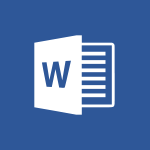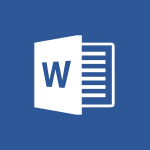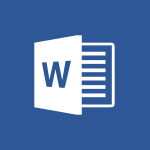Word - Use landscape and portrait orientation Video
In this video, you will learn about using landscape and portrait orientation in Microsoft 365. The video covers how to adjust the orientation of your documents and presentations to either landscape or portrait mode.
This will help you create professional-looking documents and presentations that are tailored to your specific needs.
- 3:28
- 2666 views
-
OneDrive - What is OneDrive ?
- 01:14
- Viewed 2182 times
-
Outlook - Create and modify a group
- 2:19
- Viewed 4878 times
-
OneDrive - Edit, Delete a Share
- 02:16
- Viewed 1329 times
-
Power BI - Introduction to Power Bi
- 1:29
- Viewed 6747 times
-
Teams Premium - Activate the features of Teams Premium
- 3:48
- Viewed 14268 times
-
Teams Premium - Optimize Teams Premium settings in Administration
- 1:27
- Viewed 2939 times
-
Viva Engage - The role of an administrator
- 2:22
- Viewed 5140 times
-
Collapsible headings
- 3:03
- Viewed 7119 times
-
Navigation Pane Part 1 : Rearranging a document
- 2:32
- Viewed 4113 times
-
Copy & Paste
- 3:09
- Viewed 3726 times
-
Introduction to Word
- 0:59
- Viewed 3561 times
-
Change footnote font, size, and formatting
- 2:48
- Viewed 3426 times
-
More things you can do with pictures
- 4:53
- Viewed 3297 times
-
Insert icons
- 0:43
- Viewed 3221 times
-
Introduction to Tables of Contents
- 2:57
- Viewed 3192 times
-
Locate your documents
- 0:20
- Viewed 3178 times
-
Microsoft Search
- 0:34
- Viewed 3156 times
-
More options and custom labels
- 3:59
- Viewed 3110 times
-
Use dictate to type in Word
- 0:27
- Viewed 3047 times
-
Faster shape formatting and new and modern chart types
- 1:04
- Viewed 3041 times
-
Insights into what you're working on
- 0:36
- Viewed 3035 times
-
Take tables of contents (TOCs) to the next level
- 3:51
- Viewed 3009 times
-
Mail merge
- 3:51
- Viewed 2991 times
-
3D Models
- 0:42
- Viewed 2983 times
-
Add a logo or other picture
- 3:17
- Viewed 2961 times
-
Format a document
- 2:58
- Viewed 2960 times
-
Format and add a graphic
- 3:20
- Viewed 2956 times
-
Translate Content in Word
- 2:04
- Viewed 2948 times
-
Translate your Word documents into any language
- 0:33
- Viewed 2939 times
-
Insert items in a document
- 2:59
- Viewed 2935 times
-
Save, export and share
- 2:08
- Viewed 2895 times
-
Ink Equation
- 0:43
- Viewed 2872 times
-
Let Word read your documents out loud
- 0:36
- Viewed 2860 times
-
Track changes online
- 3:14
- Viewed 2842 times
-
Edit document with natural gestures
- 0:34
- Viewed 2835 times
-
Add headers, footers, margins, and rulers to a page
- 2:45
- Viewed 2788 times
-
A first look at Word 2016
- 3:16
- Viewed 2785 times
-
Print envelopes with mail merge
- 3:58
- Viewed 2785 times
-
Accessibility in Word
- 2:29
- Viewed 2775 times
-
Design considerations for orientation
- 2:00
- Viewed 2768 times
-
Insert and customize a footnote
- 3:04
- Viewed 2755 times
-
How things are organized
- 2:00
- Viewed 2749 times
-
Check Accessibility in Word
- 1:42
- Viewed 2726 times
-
Custom margin - Headers and footers
- 1:29
- Viewed 2697 times
-
Navigation Pane Part 2 : Search Options
- 1:35
- Viewed 2677 times
-
Add multiple TOCs to a document
- 4:59
- Viewed 2677 times
-
Advanced mail merge (Field code)
- 2:59
- Viewed 2656 times
-
A closer look at the ribbon
- 3:54
- Viewed 2650 times
-
Focus on priorities with the Immersive Reader
- 1:13
- Viewed 2641 times
-
Modify a TOC with field codes
- 2:59
- Viewed 2640 times
-
Track changes in email with multiple people
- 4:36
- Viewed 2639 times
-
Create and print labels
- 3:05
- Viewed 2582 times
-
Chat with co-authors while editing
- 0:29
- Viewed 2548 times
-
Incorporate revisions with track changes
- 3:10
- Viewed 2537 times
-
Pin your important files
- 0:34
- Viewed 2507 times
-
Do things quickly with Tell Me
- 1:04
- Viewed 2494 times
-
Add custom entries to a TOC
- 3:00
- Viewed 2478 times
-
Get going fast
- 1:44
- Viewed 2467 times
-
Print letters with mail merge
- 4:02
- Viewed 2459 times
-
Use mail merge to create multiple labels
- 3:21
- Viewed 2444 times
-
Start working together in a document
- 2:03
- Viewed 2437 times
-
Add formatting to a TOC
- 3:48
- Viewed 2427 times
-
Track changes
- 2:34
- Viewed 2424 times
-
Advanced tables of contents
- 3:15
- Viewed 2412 times
-
Custom margin - Default margin
- 1:06
- Viewed 2383 times
-
Work together in real time
- 1:40
- Viewed 2376 times
-
Customize track changes
- 2:18
- Viewed 2371 times
-
Changing existing styles
- 1:08
- Viewed 2355 times
-
Styles
- 1:49
- Viewed 2330 times
-
Working with watermarks
- 2:48
- Viewed 2196 times
-
Improved version history
- 0:56
- Viewed 2175 times
-
Creating Styles
- 1:03
- Viewed 2154 times
-
Custom margin
- 1:59
- Viewed 2151 times
-
Introducing to Word
- 01:00
- Viewed 219 times
-
Introduction to PowerBI
- 00:60
- Viewed 225 times
-
Introduction to Microsoft Outlook
- 01:09
- Viewed 220 times
-
Introduction to Microsoft Insights
- 02:04
- Viewed 223 times
-
Introduction to Microsoft Viva
- 01:22
- Viewed 237 times
-
Introduction to Planner
- 00:56
- Viewed 223 times
-
Introduction to Microsoft Visio
- 02:07
- Viewed 229 times
-
Introduction to Microsoft Forms
- 00:52
- Viewed 227 times
-
Introducing to Microsoft Designer
- 00:28
- Viewed 326 times
-
Introduction to Sway
- 01:53
- Viewed 281 times
-
Introducing to Word
- 01:00
- Viewed 219 times
-
Introducing to SharePoint Premium
- 00:47
- Viewed 206 times
-
Create a call group
- 01:15
- Viewed 311 times
-
Use call delegation
- 01:07
- Viewed 179 times
-
Assign a delegate for your calls
- 01:08
- Viewed 305 times
-
Ring multiple devices simultaneously
- 01:36
- Viewed 182 times
-
Use the "Do Not Disturb" function for calls
- 01:28
- Viewed 172 times
-
Manage advanced call notifications
- 01:29
- Viewed 187 times
-
Configure audio settings for better sound quality
- 02:08
- Viewed 259 times
-
Block unwanted calls
- 01:24
- Viewed 211 times
-
Disable all call forwarding
- 01:09
- Viewed 191 times
-
Manage a call group in Teams
- 02:01
- Viewed 206 times
-
Update voicemail forwarding settings
- 01:21
- Viewed 184 times
-
Configure call forwarding to internal numbers
- 01:02
- Viewed 180 times
-
Set call forwarding to external numbers
- 01:03
- Viewed 201 times
-
Manage voicemail messages
- 01:55
- Viewed 281 times
-
Access voicemail via mobile and PC
- 02:03
- Viewed 311 times
-
Customize your voicemail greeting
- 02:17
- Viewed 180 times
-
Transfer calls with or without an announcement
- 01:38
- Viewed 189 times
-
Manage simultaneous calls
- 01:52
- Viewed 190 times
-
Support third-party apps during calls
- 01:53
- Viewed 230 times
-
Add participants quickly and securely
- 01:37
- Viewed 192 times
-
Configure call privacy and security settings
- 02:51
- Viewed 189 times
-
Manage calls on hold
- 01:20
- Viewed 182 times
-
Live transcription and generate summaries via AI
- 03:43
- Viewed 180 times
-
Use the interface to make and receive calls
- 01:21
- Viewed 187 times
-
Action Function
- 04:18
- Viewed 185 times
-
Search Function
- 03:42
- Viewed 235 times
-
Date and Time Function
- 02:53
- Viewed 226 times
-
Logical Function
- 03:14
- Viewed 349 times
-
Text Function
- 03:25
- Viewed 246 times
-
Basic Function
- 02:35
- Viewed 207 times
-
Categories of Functions in Power FX
- 01:51
- Viewed 247 times
-
Introduction to Power Fx
- 01:09
- Viewed 236 times
-
The New Calendar
- 03:14
- Viewed 383 times
-
Sections
- 02:34
- Viewed 218 times
-
Customizing Views
- 03:25
- Viewed 210 times
-
Introduction to the New Features of Microsoft Teams
- 00:47
- Viewed 420 times
-
Guide to Using the Microsoft Authenticator App
- 01:47
- Viewed 250 times
-
Turn on Multi-Factor Authentication in the Admin Section
- 02:07
- Viewed 186 times
-
Concept of Multi-Factor Authentication
- 01:51
- Viewed 229 times
Objectifs :
This video aims to teach users how to effectively use different page orientations in Microsoft Word, specifically how to switch between portrait and landscape orientations for various content types, and how to manage mixed orientations within a single document.
Chapitres :
-
Understanding Page Orientation
In Microsoft Word, choosing the right page orientation is crucial for presenting your content effectively. Portrait orientation is typically used for text-heavy documents, while landscape orientation is better suited for wide content such as tables or charts. -
Changing Page Orientation
To change the orientation of your document, follow these steps: 1. Go to the 'Layout' tab. 2. Click on 'Orientation'. 3. Select 'Landscape'. This will rotate your document 90 degrees, providing more horizontal space for your content. -
Creating Mixed Orientation Documents
You can create a document that contains both portrait and landscape pages. To do this: 1. Right-click the 'Table Selection' icon and choose 'Table Properties'. 2. Under the 'Table' tab, ensure 'Text wrapping' is set to 'None' and click 'OK'. 3. Go to the 'Layout' tab and click the 'Dialog Box Launcher' in the 'Page Setup' group. 4. On the 'Margins' tab, select 'Landscape' under 'Orientation'. 5. Click the arrow next to 'Apply to' and choose 'Selected text'. 6. Click 'OK'. This will change only the selected text to landscape orientation. -
Using Section Breaks
When you apply landscape orientation to selected text, Word automatically adds section breaks before and after the table. This allows the table to exist in its own section on a separate page, while the rest of the document remains in portrait orientation. To manually add a section break: 1. Go to the 'Layout' tab. 2. Click on 'Breaks'. 3. Under 'Section Breaks', select 'Next Page'. This feature also enables you to adjust margins specifically for landscape pages without affecting the entire document. -
Viewing Multiple Page Orientations
To view your document with both portrait and landscape pages: 1. Go to the 'View' tab. 2. Click on 'Multiple Pages'. This allows you to see how the landscape page fits within the portrait pages. -
Conclusion
By understanding how to manipulate page orientations and section breaks in Microsoft Word, you can create more visually appealing and organized documents. This flexibility allows for better presentation of diverse content types, enhancing the overall readability and effectiveness of your documents.
FAQ :
How do I change the orientation of a document in Word?
To change the orientation of a document in Word, go to the Layout tab, click on Orientation, and select either Portrait or Landscape.
Can I have both portrait and landscape pages in the same Word document?
Yes, you can have both portrait and landscape pages in the same Word document by using section breaks. Select the text you want to change, go to the Layout tab, and choose Breaks to insert a section break.
What is the purpose of section breaks in Word?
Section breaks allow you to change the layout or formatting of specific parts of a document without affecting the entire document. This includes changing margins, orientation, and other settings.
How do I adjust column widths in a table?
To adjust column widths in a table, click on the table to select it, then drag the borders of the columns to the desired width or use the Table Properties settings.
What does the 'Show/Hide Paragraph Marks' feature do?
The 'Show/Hide Paragraph Marks' feature displays formatting marks in your document, such as spaces, paragraph breaks, and section breaks, which can help you understand the layout of your document.
Quelques cas d'usages :
Creating a Report with Mixed Orientations
In a business report that includes both text and data tables, you can use portrait orientation for the text sections and landscape orientation for the tables. This improves readability and presentation.
Designing a Presentation Handout
When creating handouts for a presentation, you can use landscape orientation for slides with images or charts, while keeping text pages in portrait orientation. This allows for a more visually appealing layout.
Formatting a Research Paper
In a research paper, you may need to include wide tables or figures. By using section breaks, you can format those specific pages in landscape orientation while keeping the rest of the paper in portrait format.
Creating a Multi-Page Brochure
When designing a brochure, you can use different orientations for different sections. For example, use landscape for a wide image and portrait for text descriptions, enhancing the overall design.
Adjusting Layout for a Newsletter
In a newsletter, you can mix orientations to highlight different content types. Use landscape for large images or tables and portrait for articles, making the newsletter more engaging.
Glossaire :
Orientation
The direction in which a document is displayed or printed, typically either portrait (vertical) or landscape (horizontal).
Portrait Orientation
A vertical layout where the height of the document is greater than its width, commonly used for text documents.
Landscape Orientation
A horizontal layout where the width of the document is greater than its height, often used for tables and images.
Table Properties
Settings that define the layout and formatting of a table within a document, including text wrapping and alignment.
Text Wrapping
The way text flows around a table or image in a document. 'None' means text will not wrap around the table.
Margins
The blank spaces around the edges of a document that separate the text from the edges of the page.
Section Break
A marker in a document that divides it into sections, allowing for different formatting options in each section.
Dialog Box Launcher
An icon that opens a dialog box for more detailed settings and options related to a specific feature in a software application.




